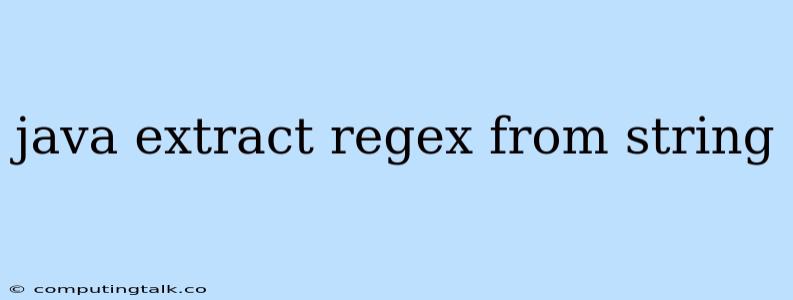Java is a powerful programming language with a wide range of applications, and regular expressions are a fundamental tool for manipulating text data. When working with Java, you might encounter situations where you need to extract specific information from a string based on a pattern. This is where Java extract regex from string comes in handy.
Understanding Regular Expressions
Regular expressions, often shortened to regex, are a sequence of characters that define a search pattern. They are used to match, extract, and manipulate text strings. In Java, you can use the java.util.regex package for working with regular expressions.
Extracting with java.util.regex.Matcher
The java.util.regex.Matcher class is crucial for extracting text from a string based on a pattern. Let's break down the process:
-
Compile the Regex: First, you need to create a
Patternobject using thecompile()method from thejava.util.regex.Patternclass. This compiles the regular expression into a pattern object. -
Create a
Matcher: Next, create aMatcherobject using thematcher()method of thePatternobject. Pass the string you want to search as an argument. -
Find Matches: Use the
find()method of theMatcherobject to locate the first match in the string. You can repeatedly callfind()to iterate through subsequent matches. -
Extract the Match: Use the
group()method of theMatcherobject to retrieve the extracted text.
Example: Extracting Email Addresses
Let's say you have a string containing various text and you want to extract all email addresses:
import java.util.regex.Matcher;
import java.util.regex.Pattern;
public class RegexExample {
public static void main(String[] args) {
String text = "Contact us at [email protected] or [email protected] for assistance.";
String regex = "\\b[A-Za-z0-9._%+-]+@[A-Za-z0-9.-]+\\.[A-Za-z]{2,}\\b";
Pattern pattern = Pattern.compile(regex);
Matcher matcher = pattern.matcher(text);
while (matcher.find()) {
System.out.println(matcher.group());
}
}
}
In this example:
- The regex
\\b[A-Za-z0-9._%+-]+@[A-Za-z0-9.-]+\\.[A-Za-z]{2,}\\bdefines the pattern for email addresses. - The
matcher.find()method iterates through all matching email addresses in the string. - The
matcher.group()method extracts the matching email addresses and prints them to the console.
Tips for Effective Regex Usage
- Start Simple: Begin with a basic regex pattern and gradually add complexity as needed.
- Test Thoroughly: Use online regex testers or Java's
Matcherclass to verify that your pattern works correctly. - Escape Special Characters: Special characters like
+,*,?,[,], and(have specific meanings in regex. Escape them with a backslash (\) to match them literally. - Use Character Classes: Character classes like
[A-Za-z0-9],\d(digits), and\s(whitespace) simplify your patterns. - Quantifiers: Quantifiers like
+(one or more),*(zero or more), and?(zero or one) control the number of repetitions.
Common Regex Patterns
- Email:
\b[A-Za-z0-9._%+-]+@[A-Za-z0-9.-]+\\.[A-Za-z]{2,}\\b - Phone Number:
\b\d{3}-\d{3}-\d{4}\b - URL:
(https?|ftp|file)://[-A-Za-z0-9+&@#/%?=~_|!:,.;]*[-A-Za-z0-9+&@#/%=~_|]
Beyond Basic Extraction
The java.util.regex.Matcher class offers more advanced functionality:
replaceAll(): Replaces all occurrences of the matched pattern with a specified string.replaceFirst(): Replaces the first occurrence of the matched pattern.groupCount(): Returns the number of capturing groups in the pattern.start()andend(): Return the start and end indices of the matched text.
Conclusion
Java extract regex from string is a powerful technique for manipulating text data. Regular expressions provide a flexible and efficient way to extract, match, and replace text based on specific patterns. By understanding the fundamentals of regular expressions and utilizing the java.util.regex.Matcher class, you can confidently handle text processing tasks in your Java applications.
